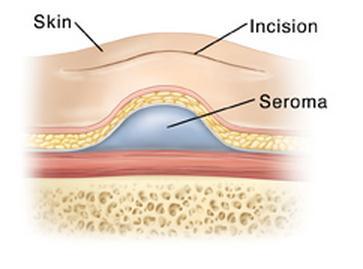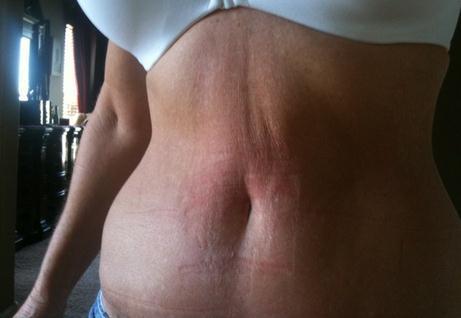What is a Seroma?
Seroma is a condition that often occurs after an operation, which results in injury to your blood and lymphatic vessels. This condition is marked with a swelling that results from damage of blood vessels, lymphatic vessels, as well as the surrounding tissues.
The swelling is usually filled with yellow or white fluids that may be seen on blisters or fresh wounds5. This fluid is referred to as serous fluid.

Types
Seromas are classified according to the cause. The following are the most common forms of seroma:
Infected seroma
Infected seroma occurs due to injuries. These injuries vary and may include those resulting from dirty medical equipment, accidents or coming into contact with an infected injury.
Surgery seroma
This type of seroma happens when your blood vessels are damaged during surgery leading to fluid accumulating below your skin.
Plastic surgery seroma
This type of seroma occurs when people undergo cosmetic surgery to enhance the appearance of particular parts of the body. Plastic surgery is conducted on the face, breast, abdomen, and other body parts.
Area of Body where Seroma Develops?
Seroma may develop on the following parts of your body:
- Abdomen
- Neck
- Breast
- Axilla
- Subcutaneous region
Causes
Seroma can be caused by various factors such as:
After surgery injury
Seroma may result after having surgery operations such as:
Mastectomy
This is a surgical operation conducted to eliminate a cancerous tumor in your breast. During mastectomy, blood vessels near your breast may be accidentally damaged. When your blood cells rapture, it triggers an inflammatory response from your body to produce blood plasma.
Blood plasma is also called serous liquid which contains serum. Serum is manufactured by serous membrane in your body. This fluid may accumulate below your skin causing seroma.
Hernia repair
It may cause accumulation of fluids causing seroma if done improperly. Hernia repair seroma affects areas near it such as abdomen or inguinal.
Abdomen surgery
Many people undergo surgery in the abdomen. During surgery procedure, the area of surgery may be left untreated or treated improperly with sutures and antiseptics. This may be due to incompetence of the health professional conducting abdominal surgery. This may lead to seroma.
Plastic surgery
Plastic surgery is a surgical procedure that deals with repairing, reconstructing and replacing physical problems on your skin, hand, breast and face.
Plastic surgery can be conducted on the face to enhance the beauty of the face or the breast and abdomen. When this plastic surgery is not done properly, it damages nearby tissues causing seroma in your neck in case it was a facial plastic surgery.

Injury: An injury to your body may also cause seroma. When your body receives a physical injury, your blood vessels and tissues may be damaged. This causes accumulation of fluids or dead cells resulting in seroma.
Symptoms
There are several symptoms of seroma that are easily noticed. They include:
- One noticeable symptom is swellings or bumps on the affected areas. Swellings occur because of accumulation of fluids or serous liquid below your skin.
- The area near the surgery site becomes tender as well red. In some cases, fluids may leak from that site.
- Seroma may also cause inflammation in the surrounding areas. For mastectomy, apart from your breast being affected, seroma will occur in your armpit and around the shoulder.
- Seroma may also harden some areas on your body. This occurs when seroma is left to heal by itself.
When to Seek Medical Attention?
You must seek urgent medical attention when you manifest the following symptoms:
- Your body temperatures are above normal causing fever
- You experience acute pain at the surgical spot
- You bleed constantly from the surgical locations
- Discharge of pus from the surgical places
Risk Factors
There several factors that may promote seroma. The common ones include:
- When surgery procedure affects many tissues and blood vessels.
- If you have a history of having seromas after surgery
- After having an extensive surgical procedure.
Diagnosis
The initial diagnosis of seroma is through physical examination. Your doctor assesses your body especially the neck, abdomen, and breasts and notes any swellings in those areas.
Seroma is also diagnosed through imaging tests to determine its exact location in your body. These tests include ultrasound and CT scan.
How do Reduce Risks of Developing Seromas?
Some of these risks occur because of patient’s ignorance. One of these problems is that patients fail to adhere to the guidelines offered by their health providers. To minimize these risks, ensure you follow the restrictions given to you by your doctor.
Treatment
Seroma is a treatable condition. Treatment of the condition may consider the size of your seroma. Small seromas may be left to heal by themselves. This is so because your body may reabsorb the fluid into the body after a certain period. For larger seromas, there are various treatment options available such as:
Fine needle aspiration/Drainage
This is a form of a biopsy procedure. In fine needle aspiration method, your doctor puts a needle into the area that has seroma and drains out the fluids. If the seroma is situated deep inside your body, your doctor will use an endoscopy which has a light and a camera fixed to direct the needle to the right affected area and removes the fluids.
In some cases, your doctor may conduct several aspirations to completely remove the fluids or place a tube in the affected areas and drain out the fluid. These fluids are then analyzed in the laboratory to determine whether pathogens are present or not.
Before undergoing aspiration test, stop taking medication such as blood thinners (warfarin) and aspirin. Also avoid eating or drinking something before the test.
Medications
Your doctor may recommend the following medicines to treat some symptoms of seroma like pain and infections:
Antibiotic
If your doctor suspects your seroma is infected with bacteria, you will be given antibiotic such as penicillins to treat bacterial infections.
Pain killers
Your doctor will prescribe pain relieving drugs to reduce pain and inflammation caused by seroma. Some of the pain killers you may be given include ibuprofen.
Surgery
It is usually rare in treating seroma. If seroma is so painful, your doctor may perform a very easy surgical procedure to eliminate it.
Complications
When seroma is left untreated for a long time, it poses serious health problems such as abscess. Abscess is a soft mass found on your skin that is enclosed with a colored region (pink or red). Abscess is severe and usually found in your armpits, areas near the anus, groin and vagina. Abscess may also cause fever if not managed early1.
Reference List
- Abscess. http://www.webmd.com/a-to-z-guides/abscess#1
- Seroma. http://www.rightdiagnosis.com/s/seroma/intro.htm
- Fine needle aspiration. http://www.webmd.com/a-to-z-guides/fine-needle-aspiration#1
- https://www.healthgrades.com/conditions/seroma–treatments
- http://www.primehealthchannel.com/seroma-definition-causes-symptoms-and-treatment.html
- Seroma. http://www.healthline.com/health/seroma#identification4

can you treat seromas with cold or warm compressions?